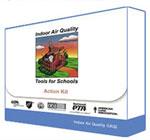Schools: Indoor Air Quality
On this page:
Creating Healthy Indoor Environments in Schools

EPA offers information and resources for school officials and staff, teachers, health care professionals, parents, and students to help improve indoor air quality in schools. Read more about:
- Indoor Air Quality Tools for Schools Action Kit
- Indoor Air Quality Design Tools for Schools
- School Advanced Ventilation Engineering Software
More about indoor air quality
- Why It's Important
- What You Can Do
- EPA and Federal Partners
- National Organizations
- Regional, State and Local Resources
Why It's Important
- Studies show that one-half of our nation's 115,000 schools have problems linked to indoor air quality (IAQ).
- Students are at greater risk because of the hours spent in school facilities and because children are often susceptible to pollutants.
- The health and comfort of students and teachers are among the many factors that contribute to learning and productivity in the classroom, which in turn affect performance and achievement.
What You Can Do
- Ensure proper maintenance of the school's HVAC system to promote ventilation.
- Install and regularly replace filters (high efficiency, if possible).
- Install carbon monoxide detectors, especially near combustion sources (e.g., boilers, stoves, hot water heaters).
- Be sure to consider indoor air quality in the design of a new school building.
- Read the Ensure Good Ventilation component of EPA's model school environmental health program with actions for schools to improve the quality of indoor air.
EPA and Federal Partners
- EPA's Indoor Air Quality website provides access to resources across EPA offices.
- EPA's Best Practices for Reducing Near-Road Air Pollution Exposure at Schools publication can be used by schools to reduce exposure to traffic-related air pollution.
- EPA's Energy Savings Plus Health: IAQ Guidelines for School Building Upgrades equips school districts to integrate indoor air quality protections into school energy efficiency retrofits and other building upgrade projects. The guidelines help school districts starting the building retrofit process to optimize energy efficiency upgrades without compromising occupant health.
- Tools for Schools Indoor Air Quality Video Exit by Rutgers University, with support from EPA, presents a two-part video to help identify, prevent and treat common IAQ issues that may arise in schools.
- Indoor Air Quality Scientific Findings Resource Bank provides information summarizing the state of scientific knowledge about the relationships between people's health and productivity and the indoor air conditions or associated building characteristics in which the people work or reside. The Resource Bank is run by the Lawrence Berkeley National Laboratory Indoor Environment Group and is funded through an interagency agreement with EPA.
- The School IAQ Assessment mobile app provides schools and school districts find strategies for addressing critical building-related environmental health issues such as ventilation, cleaning and maintenance, environmental asthma triggers, radon, and integrated pest management. The app complements existing indoor air quality management programs and can be used as the central tracking mechanism to organize building assessments and prioritize improvements.
The following links exit the site Exit
National Organizations

IAQ Champions in your area can help with peer-to-peer learning and sharing.
- Database of State Indoor Air Quality Laws, maintained by the Environmental Law Institute, is a compilation of laws that reflect a wide range of policy strategies enacted in the states. You may also download excerpts addressing radon, mold and schools.
- Healthy Air at School on the American Lung Association website helps individuals recognize indoor air quality problems and protect the air at school.
- Indoor Air Quality in Schools: Resource List by the National Clearinghouse for Educational Facilities offers an annotated list of links, books and journal articles addressing indoor air quality issues in K-12 school buildings, including building materials, maintenance practices, renovation procedures and ventilation systems.
Regional, State and Local Resources
- Sensible Steps for Healthier School Environments by EPA provides an overview of issues related to indoor air quality and ventilation in schools.
- The California Department of Public Health’s Indoor Air Quality Program provides fact sheets on indoor air quality issues affecting schools and links for more information.
- The Indoor Air Quality Program of the Washington State Department of Health provides consultation, technical assistance and training to local health jurisdictions, school districts and the public on the health effects of exposure to indoor air contaminants such as mold, asbestos and formaldehyde.
- The Indoor Air Quality in Schools section of the Minnesota Department of Health website describes the state's indoor air quality planning model for schools and explains actions you can take to improve IAQ in your school.
- Teacher's Resources from the Northwest Clean Air Agency (NWCAA) provides facts and classroom activities related to air quality and climate change. NWCAA serves schools in Island, Skagit and Whatcom Counties in Washington State.
